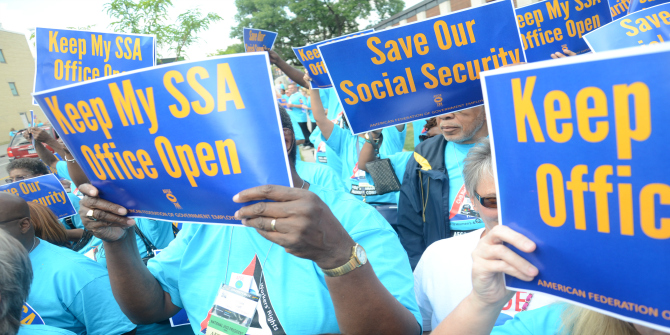In The Great Broadening: How Vast Expansion of the Policymaking Agenda Transformed American Politics, Bryan D. Jones, Sean M. Theriault and Michelle Whyman set out to prove that the period from the 1960s to the 1980s witnessed a ‘Great Broadening’ of the US government’s involvement in areas that had previously been off limits. Mining rich sources of data to provide insight into what caused this expansion and its consequences, the book should be read by anyone interested in Congress, policymaking and US political developments, writes Kyle Scott.
The Great Broadening: How Vast Expansion of the Policymaking Agenda Transformed American Politics. Bryan D. Jones, Sean M. Theriault and Michelle Whyman. University of Chicago Press. 2019.
Modern political debate involves questions regarding every area of our lives, from healthcare, to food safety, to civil rights, finance and beyond. However, this has not always been the case in the US, where the national government had originally been given a narrow grant of authority.
The broadening of national authority is not a new development in the US. George Washington had barely adjusted to his new position as President when a generous reading of the Necessary and Proper Clause led to the creation of the First Bank of the United States at the urging of Alexander Hamilton. The last institutional restraint codified in the Constitution was effectively nullified by the US Supreme Court in U.S. v. Darby Lumber (1941), when it declared that the Tenth Amendment was but a truism, thereby unleashing the US national government to do whatever it liked over the objections of the states.
The path toward expansion has not followed a linear course. There have been attempts to reign in the expansion, but the trajectory has been steady in the direction of bigger and more. In The Great Broadening: How the Vast Expansion of the Policymaking Agenda Transformed American Politics, authors Bryan D. Jones (a luminary in the field of policy and congressional research), Sean M. Theriault and Michelle Whyman set out to prove that the period from the 1960s to the 1980s was unique in US political development, providing some insight into what caused ‘the Great Broadening’ and its consequences.
According to the authors, in the 1960s and 1970s there was a Great Broadening of the government’s involvement in areas that had previously been off limits. The broadening began to plateau in the 1980s, at which point there was a thickening. This thickening is defined as more laws, more subtopics in laws and more complex laws being passed within the areas into which government had already broadened. The authors draw on multiple databases—the most utilised is the Policy Agendas Project, which was developed by Jones—and measure broadening through bill introductions, roll-call votes, passage of laws, coverage by the Congressional Quarterly, congressional hearings and other metrics that all reinforce the authors’ thesis. One of the most useful aspects of this book is that it separates the broadening from the thickening in order to discipline our discussion and future research about the scope and breadth of government authority.
The primary outcomes of the broadening and subsequent thickening are that Congress moved from lawmaking to oversight; interest group activity grew; social movements rose to combat competing initiatives; parties in government polarised which precipitated a polarisation in the general public; the corpus of law grew much larger; and the docket of the Supreme Court expanded. The authors set out to demonstrate that a broadening has occurred, but put a much greater emphasis on ‘delineating’ the consequences. The two most striking that will no doubt lead to additional work are the claims that the rise of interest group activity and polarisation were consequences, and not causes, of the broadening. Particularly in the case of interest group activity, this goes against much of the conventional thought on issue expansion in Congress.
The authors do not aim to be the definitive voice on what has caused the broadening, or resulted from it, and readily admit that they do not prove their thesis absolutely. Rather, they offer a ‘plausibility analysis’ in which they seek to offer reasonable explanations. Too often academics get caught up in making marginal changes to well-researched topics which typically result in a battle over methodology and measurement rather than an engagement with substance. It is refreshing, and needed, to see scholars take a big chance with their research. The authors deploy multiple modes of analysis and a disciplined methodology without getting bogged down unnecessarily with the tools of the trade. Instead, the authors recognise that there are more sophisticated approaches and encourage others to take what they have developed and refine it. No single work can do everything and this book develops and sufficiently tests big ideas; it is up to others to now iterate and refine.
The paradigm the authors have constructed can potentially cross over from congressional scholars and inform research by those studying institutional dynamics, public opinion and the interplay between and among each in policy formation. And the authors are not bashful about their ambitions. They consistently draw parallels between their work and discipline-defining scholarship in cosmology, physics, geology and biology. The repeated references to the natural sciences are unnecessary—in truth they come off as a bit pretentious, if not conveying a slight case of science envy, since political science has its own discipline-defining achievements that could also be referenced. Since this book is geared towards advanced graduate students and researchers in American politics, political science parallels would have been more appropriate examples.
It is also disconcerting that the authors do not meaningfully engage with the literature relevant to broadening. For instance, in citing research that has also noticed a broadening, the authors reference only six studies—all of which are chapters from the same edited volume. A broader engagement with the literature on the topic would have been helpful to let the reader know that there is some contention over whether the government has broadened its scope. As it stands now, the authors can justifiably be accused of using a battering ram to knock down an open door (I’m unaware of any work in a major journal or from a top publisher that convincingly argues that the scope of government has gotten smaller in the US).
The authors’ claim that social movements are the primary cause of the broadening seems plausible, but it is rather thin since no alternatives are seriously considered. For instance, the reason for broadening may have nothing to do with social movements and everything to do with consistency and cohesion. The authors convincingly argue that neither party is more complicit in the broadening, but they do not address party control: that is, a political party can be more effective if it holds a majority for an extended period of time. From 1940-95 the Democrats had a majority in the House except for four years. During this time of Democratic dominance there were only four different Speakers, with Sam Rayburn and Tip O’Neill serving lengthy terms at the beginning and end of this run. Also, from 1955-81 and 1987-95, there was a Democratic majority in the Senate. Consistent leadership could help stabilise agenda-setting between terms and maintain party discipline. Perhaps the simplest explanation for the Great Broadening is that things got done during this period because things could get done. Consistent single-party control of Congress and stable leadership created an environment ripe for broadening.
The authors end the book by demonstrating that broadening is not party specific in that when a party has control, it expands into new areas. The only difference between parties is in which areas they find it necessary to expand. For instance, the Democrats pushed for broadening in civil rights and environmental regulation and Republicans pushed for more involvement in crime control. This conclusion and its reasoning builds upon the work of E.E. Schattschneider, whom the authors cite favourably, most notably his seminal 1960 book, The Semisovereign People.
The authors mine rich sources of data and take a multi-method approach to understanding the Great Broadening and its consequences. The authors are careful, insightful and willing to take big chances while saying something important about American politics. They should be applauded for their efforts and the book should be read by those interested in Congress, policymaking and US political developments. Anyone looking for a good research project in these areas can simply open the book at any chapter and get started. The authors have done an admirable job putting forth and addressing the important issues around government broadening, and they have done a service to the discipline by giving us a framework by which to continue examining this.
Note: This review gives the views of the author, and not the position of the LSE Review of Books blog, or of the London School of Economics.
Image Credit: Masakazu Matsumoto CC BY 2.0.


 Find this book:
Find this book: 






1 Comments